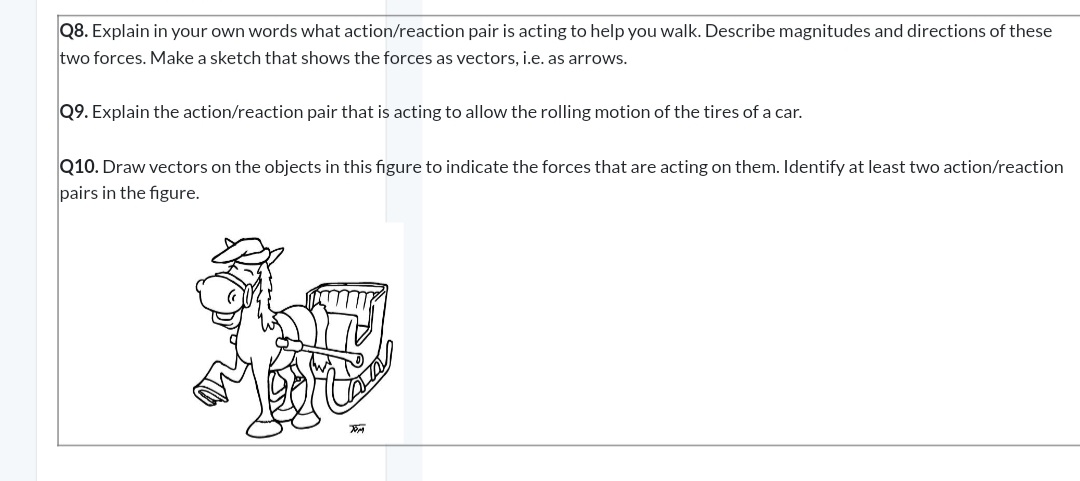Q5. Two cars have the same engine and wheels. It is determined experimentally that both cars produce the same force over a 100 meter course. Car A can accelerate twice as fast as Car B. Explain this result using Newton's Second Law.
Q5. Two cars have the same engine and wheels. It is determined experimentally that both cars produce the same force over a 100 meter course. Car A can accelerate twice as fast as Car B. Explain this result using Newton's Second Law.
College Physics
1st Edition
ISBN:9781938168000
Author:Paul Peter Urone, Roger Hinrichs
Publisher:Paul Peter Urone, Roger Hinrichs
Chapter4: Dynamics: Force And Newton's Laws Of Motion
Section: Chapter Questions
Problem 23PE: A 5.00105 -kg rocket is accelerating straight up. Its engines produce 1.250107 N of thrust, and air...
Related questions
Topic Video
Question
100%
![Q5. Two cars have the same engine and wheels. It is determined experimentally that both cars produce the same force over a 100
meter course. Car A can accelerate twice as fast as Car B. Explain this result using Newton's Second Law.
Q6. Michele kicks a 0.75 kg ball with a 45 N force. What is the acceleration of the ball?
Q7. Fill in the blanks in the table below, submit your results in the text box by letter [3(a), (b), (c), etc.]:
(c)
(f)
(g)
Force (N)
+9.3 x 10¹2 N
+2.1 x 105 N
(i)
-15 N
+22 N
-150 N
-225 N
(b)
(d)
(h)
mass (kg)
3.0 kg
8.4 x 10³ kg
2.8 x 10-6 kg
67 kg
(j)
19 kg
128 kg
acceleration (m/s²)
(a)
+5.5 m/s²
-2.0 m/s²
+6.2 x 10³ m/s²
(e)
-1.2 x 108 m/s²
-9.8 m/s²
-9.8 m/s²
-9.8 m/s²
-9.8 m/s²](/v2/_next/image?url=https%3A%2F%2Fcontent.bartleby.com%2Fqna-images%2Fquestion%2Fedcf501e-aa4c-4144-873b-4cb5a00348f2%2Fa0bbe918-6763-4a23-b354-f4ec64a25f86%2F7b7k6j_processed.jpeg&w=3840&q=75)
Transcribed Image Text:Q5. Two cars have the same engine and wheels. It is determined experimentally that both cars produce the same force over a 100
meter course. Car A can accelerate twice as fast as Car B. Explain this result using Newton's Second Law.
Q6. Michele kicks a 0.75 kg ball with a 45 N force. What is the acceleration of the ball?
Q7. Fill in the blanks in the table below, submit your results in the text box by letter [3(a), (b), (c), etc.]:
(c)
(f)
(g)
Force (N)
+9.3 x 10¹2 N
+2.1 x 105 N
(i)
-15 N
+22 N
-150 N
-225 N
(b)
(d)
(h)
mass (kg)
3.0 kg
8.4 x 10³ kg
2.8 x 10-6 kg
67 kg
(j)
19 kg
128 kg
acceleration (m/s²)
(a)
+5.5 m/s²
-2.0 m/s²
+6.2 x 10³ m/s²
(e)
-1.2 x 108 m/s²
-9.8 m/s²
-9.8 m/s²
-9.8 m/s²
-9.8 m/s²

Transcribed Image Text:Q8. Explain in your own words what action/reaction pair is acting to help you walk. Describe magnitudes and directions of these
two forces. Make a sketch that shows the forces as vectors, i.e. as arrows.
Q9. Explain the action/reaction pair that is acting to allow the rolling motion of the tires of a car.
Q10. Draw vectors on the objects in this figure to indicate the forces that are acting on them. Identify at least two action/reaction
pairs in the figure.
TOM
Expert Solution
This question has been solved!
Explore an expertly crafted, step-by-step solution for a thorough understanding of key concepts.
This is a popular solution!
Trending now
This is a popular solution!
Step by step
Solved in 3 steps

Knowledge Booster
Learn more about
Need a deep-dive on the concept behind this application? Look no further. Learn more about this topic, physics and related others by exploring similar questions and additional content below.Recommended textbooks for you

College Physics
Physics
ISBN:
9781938168000
Author:
Paul Peter Urone, Roger Hinrichs
Publisher:
OpenStax College

Glencoe Physics: Principles and Problems, Student…
Physics
ISBN:
9780078807213
Author:
Paul W. Zitzewitz
Publisher:
Glencoe/McGraw-Hill

College Physics
Physics
ISBN:
9781285737027
Author:
Raymond A. Serway, Chris Vuille
Publisher:
Cengage Learning

College Physics
Physics
ISBN:
9781938168000
Author:
Paul Peter Urone, Roger Hinrichs
Publisher:
OpenStax College

Glencoe Physics: Principles and Problems, Student…
Physics
ISBN:
9780078807213
Author:
Paul W. Zitzewitz
Publisher:
Glencoe/McGraw-Hill

College Physics
Physics
ISBN:
9781285737027
Author:
Raymond A. Serway, Chris Vuille
Publisher:
Cengage Learning


College Physics
Physics
ISBN:
9781305952300
Author:
Raymond A. Serway, Chris Vuille
Publisher:
Cengage Learning